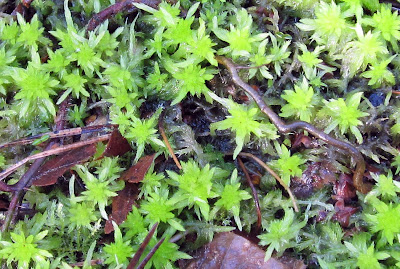 |
| Mnium hornum in the old gravel pit on Keston Common |
A moss walk around the common, on Saturday 19th March, was led by a local botanist, Jan Hendey, accompanied by the BCS ranger, Judith John.
It was sunny and fresh, so we didn't freeze as we had on the recent Hayes Commmon lichen walk. Jan is a real expert and we walked around examining the beautiful mosses with hand lenses loaned by Judy.
Most of the mosses could be identified with just the lens, and you really do need the lens. As with all specialisms, if you are really familiar with them you can see many differences at a glance. Jan was naming most of the mosses on sight, and only confrming the identification with the lens; but even Jan was wrong once.
 |
| Botanist Jan Hendey handing out a moss specimen on Keston Common |
The moss species we looked at were common, which allowed for pieces to be passed out to everyone to examine.
We were on the southern part of the common, which is on Blackheath gravel and has acid soil. The rangers are gradually clearing trees and shrubs to allow it to revert to its previous heathland status; on the left we were on Ling heath (Calluna vulgaris) with Scots Pine and Silver Birch in the background. There is plenty of gorse just out of sight.
There are about 500 species of moss in Kent. We were shown 13: Mnium hornum, Dicranium scoparium, Hypnum cupressiforme, Rhytidiadelphus squarrosus, Brachythecium albicans, Campylopus flexuosus, Scleropodium purum, Pleurozium schreberi, Hypnum jutlandicum, Eurynchium praelongum (aka Kindbergia praelonga), Polytrichum commune, Sphagnum fallax and Fontinalis antipyretica. We learned something of how the names sometimes matched their appearance. If you see "common names" for mosses, they are nearly all recent inventions.
 |
| Sphagnum fallax in Keston bog |
The last named, Fontinalis antipyretica, grows in the water of the Keston Ponds and looks like a water weed. One of the group had read that it was used in Scandinavia to put out chimney fires, which if true would account for its name.
Other sightings included a scarce hoary cinquefoil on the heath, and a Brimstone butterfly, fluttering through the car park as we left.
 |
| Fontinalis antipyretica picked out of Keston Pond |
Wonderful. 500 species. Have other continents so many? I wonder whether our "duck weed" is a moss, too. There is everything to learn.
ReplyDelete